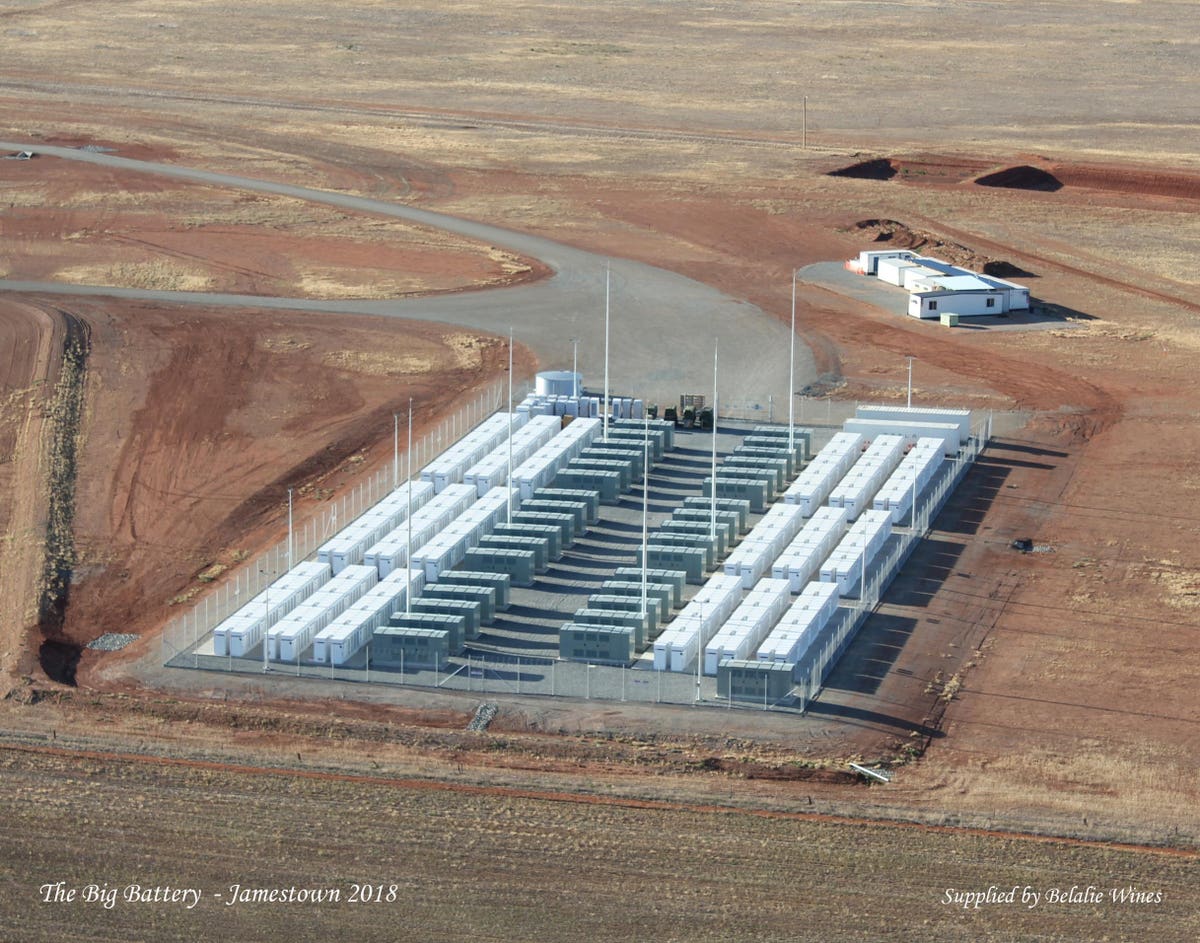This article follows an earlier one entitled Three Reasons Oil And Gas Should Keep An Eye On The Battery Transition.
Battery deployment in Australia.
What can the U.S. learn from the transition from fossil to renewable energies in Australia? Some aspects of this are truly remarkable.
Step 1 was in-home batteries charged by rooftop solar, fast becoming a big deal in Australia. Less use of grid power can displace coal-fired power plants and quite possibly gas-fired power plants.
Step 2 was EV batteries. Like the U.S., uptake of EVs has been slow compared with several other countries. So the effect this has on displacing gasoline cars and crude oil production is not significant – yet.
Step 3 was large-scale grid batteries. Australia is stepping out, but it varies by state. Tasmania (99%), South Australia (72%), and Western Australia (31%) are states most committed to renewables. South Australia has four big-batteries at Hornsdale, Lake Bonney, Dalrymple, and Torrens Island.
But NSW, Victoria, and Queensland are indentured to legacy coal-fired power plants because these states are rich in coal, which contributes to the country’s number 1 rank in the world for coal exports. These states are now investing in big-batteries and wind/solar farms as coal power plants enter their retirement window.
The back-story. In 2016 a hiccup occurred in South Australia’s transition from coal to wind and solar, when the entire state suffered a blackout for a day or so (I was there at the time). Mike Cannon-Brookes, a tech billionaire, placed a bet with Elon Musk about whether he could build a grid battery that would protect the state from future blackouts. Tesla
TSLA
A revolutionary idea in the search for renewable resilience, the 100 MegaWatt (MW) big-battery was called the Tesla battery until it was bought by Neoen, and it was the largest in the world. It was expanded to 150 MW in 2019. One concern was how long could a big-battery provide power in case of a disruption? The latest big-batteries can provide full power for about 4 hours or half-power for 8 hours and can at least get their constituents through the night.
Big-batteries are booming now in Australia. As of one year ago, there were 800 MW of power that were provided by more than 15 such grid-battery projects.
During the next five years an additional 3,600 MW will be supplied by 18 new projects, making a total above 4,000 MW or 4 GW. Over ten times this amount is projected for 2050.
Homeowners, utility providers, and governments are having a tough time in Australia adapting to all the changes. You have to be an accountant to figure out the financial benefits of a rooftop solar plus a home battery. Utilities have to ensure they continue to make a profit while unknown numbers of homeowners pull away from the grid, and governments have a hard time keeping up with new policies and regulations.
AGL is an Australian energy company with electricity, gas, solar, and renewable energy services. The AGL story is important because it’s the largest coal-fired power plant company in Australia. And it says it’s shutting down its last two coal power plants by 2035. AGL is a story of proactive energy transition that may resonate with utility companies in the U.S.
AGL has completed a 250 MW battery at Torrens Island in South Australia. They anticipate a final decision on a 500 MW battery at Liddell in New South Wales by the end of 2023.
Three other huge batteries are in the development pipeline: 500 MW in NSW, 400 MW in NSW, and 500 MW in Queensland.
But AGL are also investing in wind and solar energies: 6.3 GW of new wind and solar capacity by 2035, which compares with 5.9 GW of storage capacity by 2035. This is only a bit less than plans by Origin Energy’s 14 GW of total new capacity. Origin Energy is an Australia electricity provider and natural gas supplier.
AGL provide interesting clues to their perspective. First, AGL expects that electrification of households, especially EVs, will result in a massive shift to wind and solar.
Second, as a result, coal power stations will be the first to go, but AGL also foresee a gradual decline in demand for natural gas.
Third, and surprisingly, AGL anticipate that big-batteries will make higher financial returns on their investment than solar or wind farms.
South Australia.
South Australia has a unique story to tell in regard to its enviable success in renewable energies.
When averaged over the last 12 months, 70% of the state’s electricity comes from renewable sources. According to ElectraNet, the state could reach 100% renewables earlier than the self-imposed target of 2030.
Rooftop solar is rampant and can provide 100% of the state’s demand, but just in the daytime. This fits with the dubious distinction of the state being the driest state in the driest continent of the world.
One quote sums it up nicely: “South Australia remains at the forefront of gigawatt-scale zero emission electrical systems globally.”
Some other facts not widely reported:
· 40% of homes in South Australia have rooftop solar, and 30,000 residences have home batteries installed. This in a state that has a population of only 1.8 million.
· A renewable-electrified home operates like this: the home is powered from the rooftop first. Then excess electricity is fed into the home battery. When the battery is fully charged, any excess electricity goes into the grid.
· Wind farms in South Australia are located at Hornsdale, Lake Bonney, Hallett, Snowtown, and Cape Jervis.
· Solar farms that use photo-voltaics are located in Port Augusta, Mannum, Tailem Bend, Coonalpyn and Streaky Bay.
And from another report:
· South Australia has shown the world what can be done. It has lifted its energy systems from 1% to over 70% renewable energy in just over 16 years.
· On 180 separate days in 2021, renewables met 100% of electricity demand.
· South Australia is a small state with a big vision from its government: “(1) large-scale renewable energy generation and storage such as wind, solar PV, solar thermal, batteries, pumped hydro, compressed air and thermal storage, (2) distributed energy resources such as rooftop solar, bioenergy and batteries, and (3) hydrogen production, use and export.”
· Building a virtual power plant (SA VPP) which would create a network of 50,000 rooftop solar and Tesla Powerwall home battery systems across the state. Working together to define a “community” virtual power plant, this plan would pull together the state government, Tesla, and Energy Locals, an electricity retailer.
If this foretells the future of U.S. energy, and potential displacement of fossil fuels by renewables, the oil and gas industry would be wise to look at this with eyes wide open.
Takeaways.
Some aspects of the energy transition in Australia are truly remarkable.
The 2017 Tesla battery in Hornsdale was a revolutionary idea in the search for renewable resilience, and at 100 MW was the biggest in the world.
Big-batteries are booming now in Australia. As of one year ago, there were 800 MW of power that were provided by more than 15 such grid-battery projects.
AGL has just completed a 250 MW battery at Torrens Island in South Australia. They anticipate a final decision on a 500 MW battery at Liddell in New South Wales by the end of 2023. Three other huge batteries are in the AGL pipeline: 500 MW in NSW, 400 MW in NSW, and 500 MW in Queensland.
AGL is a story of proactive energy transition that may resonate with utility companies in the U.S. AGL expects that electrification of households, especially EVs, will result in a massive shift to wind and solar. AGL also anticipates that big-batteries will make higher financial returns on their investment than solar or wind farms.
70% of the South Australia’s electricity comes from renewable sources. This was achieved in just over 16 years. On 180 separate days in 2021, renewables met 100% of electricity demand.
40% of homes in South Australia have rooftop solar that can provide 100% of the state’s demand, but just in the daytime. 30,000 residences have home batteries installed. This in a state that has a population of only 1.8 million.
A radical plan is to build a “community” virtual power plant that would create a network of 50,000 rooftop solar and Tesla Powerwall home battery systems across South Australia.
If this foretells the future of U.S. energy, and potential displacement of fossil fuels by renewables, the oil and gas industry would be wise to look at this with eyes wide open.
“As batteries grow, oil and gas will slow.” (Anonymous overseas comment).
Read the full article here





